Table of Contents
- Ball Rod and Pebble Mills
- Ball Loads
- Screens and Flakiness
- Units of Surface
- Batch and Continuous Grinding Compared
- Batch Ball Milling at Various Speeds and Ore Charges
- Best Wet and Dry Batch Ball Milling
- Selection of Volume of Ball Loads in Continuous Dry Open Circuit Grinding
- Nonferrous Media and Steel Balls Compared
- Sillimanite Balls
- Tetrahedrons and Spherical Balls Compared
- Battered Reject Balls and New Spherical Balls Compared
- Mills of Different Diameter and Length Compared
- Conclusions from Experimental Evidence on Important Points in Fine Grinding
- Innovations in Fine Grinding
- Batch and Open-Grinding Circuit
- Conclusions on Innovations in Fine Grinding
Three “ores” were used in the Ball Mill Grinding experiments. It is doubtful whether material more resistant to grinding can be found among the world’s ores. When flotation was newer and regarded as the panacea in ore treatment, the Tri-State operators were critized for not grinding the entire mill feed to flotation size and thereby increase the recovery. Herein are power estimates for the grinding. They will belie the critics. One of the best exhibits of the resistance of chert to grinding is a chart by Maxson, who kindly made comparative grinding tests and showed by a private communication that the chert would be at the extreme lower limit of the series of a large group of ores that he and his associates had examined. The material obtained for the present investigation had only 0.4 percent through 200-mesh.
The dolomite was from the southeast Missouri lead district and also was well deslimed. Dolomite A had only 1 percent through 200 mesh; also, like the chert, about 80 percent of its weight was on three consecutive sieves. The good sizing is due to the combined effect of the hydraulic classifier and to the concentrating table from which the sample was taken. The chert and dolomite A illustrate to what extent fine material can be sized without screens. The dolomite is about three times as grindable as the chert. Dolomite B is the laboratory drag “sand” accumulated from grinding tests on dolomite A. None of these materials had more than 1 percent of sulphides and hence they may be regarded as one-mineral products. This made interpretation of the tests easier.
The advantage in selecting two samples of such different grindability was not appreciated until the work was well under way. By the rotation practiced, many fundamentals not discernible by testing a single ore were brought out.
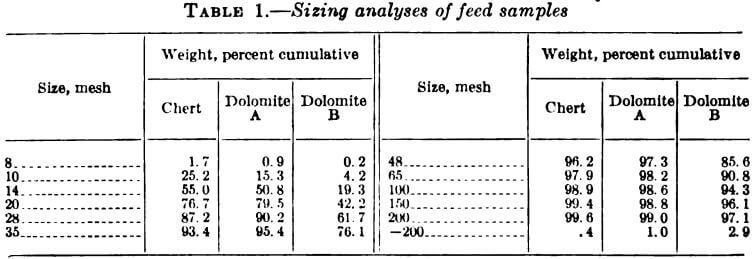
Ball Rod and Pebble Mills
Both cylindrical and conical mills were used. The cylindrical mills had the following dimensions: 19- by 36-inch unit type, 19- by 36-inch sectionalized with a grid, 24- by 24-inch, and 24- by 36-inch.
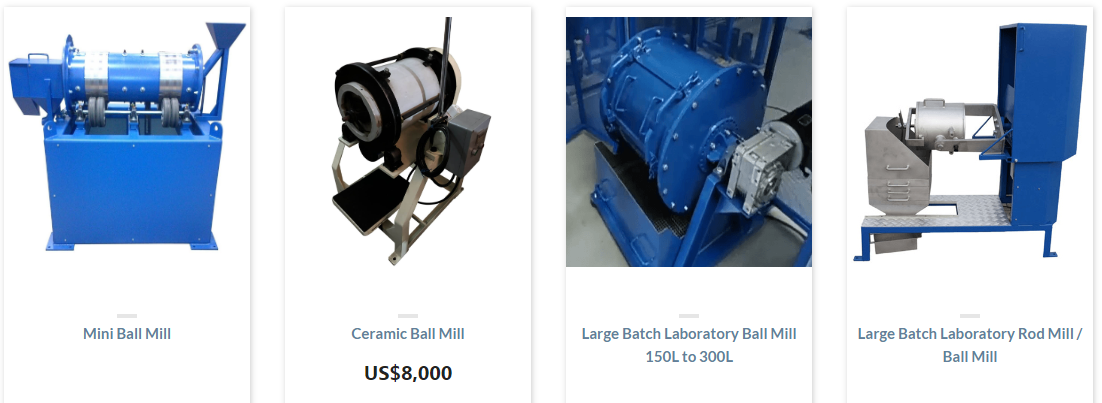 Three conical mills were used. Two of these were made by lining a 24- by 36-inch drum. The first was lined so that the dimensions were 22.5 by 16.5 by 36 inches. The second was lined so that it contained a succession of three truncated cones, all apexing toward the discharge end. Each of the three truncated cones was 21 by 17 by 12 inches, so that the total length was 36 inches. The third conical mill had dimensions of 23.5 by 11.6 by 72 inches.
Three conical mills were used. Two of these were made by lining a 24- by 36-inch drum. The first was lined so that the dimensions were 22.5 by 16.5 by 36 inches. The second was lined so that it contained a succession of three truncated cones, all apexing toward the discharge end. Each of the three truncated cones was 21 by 17 by 12 inches, so that the total length was 36 inches. The third conical mill had dimensions of 23.5 by 11.6 by 72 inches.
None of the mills were equipped with liners, as commonly conceived by operators; in fact, the shells were the liners, but lifters with moderate projections always were employed. Drum feeders were used in preference to scoop feeders.
The mounting of the mills was of the tire-and-roller type, thus leaving the ends accessible for changes. The mills were driven by spur and pinion with the spur wheel attached to the head. The pinion was mounted on a countershaft with a silent chain drive connecting it to a direct-current motor. Roller bearings were used throughout. The distribution of the motor losses and friction losses (dead load) of the 19- by 36-inch mill have been published already. There, after all possible means had been employed to reduce friction loss to a minimum, it is seen to be considerable. More will be said about this under “Power”.
https://www.911metallurgist.com/variables-affecting-grinding-mill-power/
Ball Loads
The ball loads are illustrated in table 2. The first two loads have the designation “Davis” because Davis ingeniously developed the formula from which the sizing analyses were derived. He took into account rate of wear of the different sizes and derived a load balanced against that wear when the renewal and rejection sizes were given. His formula considered nothing but “balance”. He did not question the adaptability of his certain distribution of ball sizes to the particular distribution of particle sizes. In the present paper an attempt has been made to ascertain the amount of a given size of balls required for an estimated amount of a given particle size of ore, and this new load is called the “rationed load”.
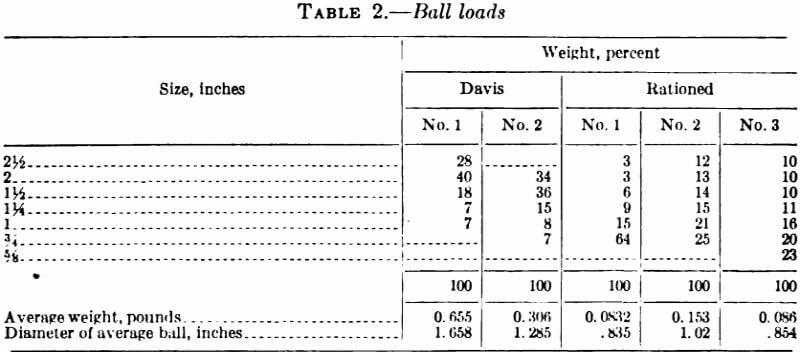
The rationed loads are the result of a more or less scientific system of reasoning (not given here), in which the ball size is not only best adapted to the particle size but also the amount of balls is rationed to the amount of the particle sizes and takes into account the finishing size.
After the spherical balls, other grinding media were used. They were tetrahedrons, worn and battered balls, flint pebbles, sillimanite balls, rods, and pipes stuffed successively with materials of different density to give grinding media of different weights while the dimensions remained the same.
The grinding medium and the ore will be called “load” and “charge”, respectively.
Screens and Flakiness
Square-mesh screens were used to obtain the sized products in the various tables. At an early date, flakiness had been studied by screening on square-hole screens, then screening each size on a “rectang” screen of a selected size. The amount that passed the rectang gave a measure of flakiness. There it was shown how flakiness varies in successive steps of grinding. This procedure and other methods for flakiness tests would be necessary if absolute surface values were required or if different types of grinding machines needed close scrutiny, but in this work it was deemed desirable to stick to the regular methods until more elementary things had been worked out.
The work has been conducted in such manner that, although many surface calculations are made by a method already outlined, they are little more than supplementary. That is, the ultimate results, as based on square-hole screens, may be seen at a glance, then surface calculations are made so as to combine the several characteristics into one numerical value. The necessity of subsieve examinations has been minimized by conducting the comparative tests so that each product of a series has about the same amount through 200-mesh.
It is fully realized that products from grinding a given ore by diversified methods might have exactly the same amount of the minus 200-mesh size and yet have a different distribution of the sub sieve sizes. In fact, the evidence is that the distribution would be different because an abundance of tests in this report show that (when the amount of minus 200-mesh is the same) the distribution of the sieve sizes is different, hence the distribution of the subsieve sizes would be expected to be different.
Units of Surface
In accordance with one of the first papers, the grinding rate or capacity and the grinding efficiency are expressed as surface tons per hour, and surface tons per horsepower-hour, respectively. Some calculations were again carried out in full in a later paper. This method has been used for several years by one of the largest mining companies, which has supplied the Bureau with many photostats of plant tests.
The method simply applies the well-established inverse ratios—that is, for example, the amount of surface in a unit weight of a ½-inch product is twice that of a 1-inch product and, similarly, the amount of surface in a unit weight of a 200-mesh product is twice that of a 100-mesh product. It was convenient to set the number 1 as a unit of surface of a unit weight of 1-inch material. By inverse ratio 361 is the units of surface in a unit weight of 150- to 200-mesh product. These units may be extended beyond the subsieve sizes after elutriation. Absolute values may be assigned after elutriation if they are available, but for comparisons the relative values given above are just as good.
The uncertainties of assigning units of surface to the subsieve sizes which have not been elutriated has caused some investigators much anxiety. Sometimes the assignments have been guarded by the term “useful grinding”, which meant that the machine was given the same credit as if the subsieve particles were only small enough to pass that last sieve. Reporting in terms of useful grinding is still practiced in this paper. Obviously, this method fails to give the machine its full due. In this report tests are compared only when the amounts of subsieve sizes are nearly the same.
Many opportunities have been given to learn what is meant by “amounts of subsieve sizes are nearly the same.” Repeat tests had to be made to get this sameness in the minus 200-mesh products. If tests were of the batch type, the correct time period had to be found by trial, or if they were of the continuous type the proper feed rate had to be found. Complete calculations were made always, whether or not the results were to be used for final record. The conclusion was reached that if the percentages of minus 200-mesh products did not differ by more than 3 percent, then the test could be recorded for final comparison.
At first thought it would seem that if two tests, one with 10 percent and the other with 13 percent minus 200-mesh material, are to be compared by means of the surface calculations for useful grinding the one with 10 percent would yield the higher efficiency values. But this is not necessarily true; the test with 13 percent might show the higher efficiency because the grinding medium was too small and had to work with inefficiency in the first part of the period and only began to work with advantage after some reduction of particle size had taken place.
An attempt to assign absolute values, as, for example, kg-cm per cm² to the calculated values obtained in this paper would not only be useless but it would lead to conclusions that are basically wrong. Only when thorough elutriation, or its equivalent, of the subsieve sizes has been practiced can absolute surface values be assigned.
Now that the general principles of useful grinding have been gleaned, the future work of seeking fundamentals will be studied by applying surface values obtained by extending the relative values into the subsieve sizes. When that is done, the densities of the various minerals will enter into the calculations.
In this paper, chert and dolomite have been treated as if they had the same density, when in reality a unit weight of a given screen size of chert would be expected to have more surface than dolomite.
Methods for calculating useful grinding will always be serviceable, but they are not wholly comprehensive and with the passage of time more and more need for dissection of subsieve sizes will be felt. Record should be made here that the “subsieve age” is imminent. Operators explain that whereas they used to sell nonmetallic products on 200-mesh specifications, now the 10-micron size is the pivotal point. They are beginning to make deprecatory remarks about the 200-mesh sieve by calling it a “boulder screen.” This warns technical workers that they have made only a beginning with their hydraulic elutriators, pneumatic elutriators, sedimentation balances, Buoyoucos hydrometer, and turbidimeters.
The sizing analyses in the tables are cumulative; this step having been performed after the surface calculations were completed.
Batch and Continuous Grinding Compared
Batch Ball Milling at Various Speeds and Ore Charges
Best Wet and Dry Batch Ball Milling
Selection of Volume of Ball Loads in Continuous Dry Open Circuit Grinding
Nonferrous Media and Steel Balls Compared
Sillimanite Balls
Tetrahedrons and Spherical Balls Compared
Battered Reject Balls and New Spherical Balls Compared
Mills of Different Diameter and Length Compared
Conclusions from Experimental Evidence on Important Points in Fine Grinding
- When identical pipes were stuffed with a variety of substances to simulate rods of different densities, and the mode of operation and the loadings were otherwise alike, the power to run the mill with the respective pipe loads varied as the weight of pipes plus ore plus water.
- Pipes stuffed with heavy material gave moderately better selective grinding of chert than did the light pipes; hence, density as well as diameter should be considered in the study of fundamentals relative to grinding media. The calculated efficiencies at all densities and speeds were about the same. The work of regular rods of the same diameter as the pipes was superior by about 35 percent.
- A change in particle size effects a change in power. The power dropped 8 percent in grinding from one-half on 14-mesh to the same amount on 48-mesh. By using a charge with a much coarser particle size and not continuing the run too long the test could have been devised so that the power range would have been reversed.
- When the speed was not too high in batch grinding, a thick pulp was desirable for capacity, but a thin pulp was better for efficiency. In open-circuit grinding, a pulp thinner than 43 percent solids was not satisfactory. In continuous grinding the indications were that the pulp consistency in the mill is the same as in the effluent.
- The range of satisfactory speeds for the rod mill was more limited than for the ball mill. High speeds were not efficient, whereas the ball-mill efficiencies did not vary much between 30 and 80 percent of the critical. Large discharge openings in the rod mill were always desirable.
- Wet rod milling showed the best efficiency and capacity with only 25 pounds of ore in the mill; 39 pounds were required to fill the interstices.
- Batch grinding was like open-circuit grinding when the amounts of media, ore, and water in the mill were the same. The types of grind, capacities, efficiencies, and powers were the same.
- Rods did more grinding than an equal volume of balls, but more power was required.
- Rods of extremely small diameter gave more selective grinding than large balls. The rods, being 35 inches long, were heavier than the balls. Undoubtedly, weight was a more important factor than the diameter of the medium in the grinding of coarse particles. Angle of nip does not explain the findings.
- In wet-batch ball milling with ore charges from 200 to 35 pounds (about 75 pounds of ore was required to fill the interstices of the balls at rest) and speeds from 30 to 80 percent critical, the slow speed gave the same type of grinding as high speed. Heavy ore charges yielded a little more selective grinding of the coarse particles than light charges. Best capacities were obtained with light charges and slightly better efficiencies were obtained with heavy ore charges. To split hairs about efficiencies at various speeds the reader will have to study the table and be his own judge.
- Some of the characteristics of dry-batch ball milling were unlike those of wet grinding. In the dry work, efficiency as well as capacity were best with the light ore charge. Power decreased with decrease in the amount of ore in the mill; in wet grinding it increased with a decrease in the amount of ore in the mill. In dry grinding high speed was more efficient than low speed.
- In comparing wet and dry grinding the tests were paired so that all the set variables were the same, except pulp consistency (wet or dry). With an intermediate weight of ore charge, selective grinding was of the same degree; with a heavy ore charge, wet grinding was more selective, and with the light ore charge, dry grinding was more selective.
- In comparing wet and dry open-circuit ball milling, wet grinding gave 39 percent more capacity and 26 percent more efficiency.
- A small ball volume was not satisfactory in the overflow type of dry mill because too much ore built up in the mill. When building up the ore was prevented by simulating the low pulp-level mill, the small ball volume did good work.
- With 60 percent solids, pebbles the same size as balls did about the same type of work as balls when dolomite was ground, but they failed in selective grinding of chert. Pebbles gave about 35 percent of the capacity and 81 percent of the efficiency shown by the balls.
- For hard and medium-hard ores, tetrahedrons were unsatisfactory for coarse grinding.
- Very hard balls (Ni-hard) were better than ordinary balls; this was particularly so when the ore was very hard.
- The efficiency of battered reject balls was about 11 percent less than that of new spherical balls.
- A ball mill as small as, 19 by 36, inches duplicated the work of a plant-size mill. The tests led to the belief that if each of a variety of mills, large or small, is run under the same conditions, and if each applies a unit of work to a unit of ore, the effect (comminution), as indicated by the products, will be the same—that is, the same relation between cause and effect will maintain.
Innovations in Fine Grinding
Batch and Open-Grinding Circuit
First will be given the results in batch and open-circuit grinding, after which closed-circuit grinding will be taken up.
Concentric Drums in Cylindrical Mills
A member of the research staff of a large company asked the Rolla station to investigate the concentric drum in a cylindrical mill. He displayed working models that gave evidence of having had serious thought expended on them and stated that in a cement plant the drum had been given a preliminary trial with favorable results. Other operators had expressed interest in similar devices. Hence, the problem was studied in more detail than if the interest had been local. The object of the drum was to increase impact and reduce attrition. This was to be accomplished by having the balls carried over the drum and dropped or thrown when they reached the descending side. It was acknowledged that the drum would occupy space that otherwise would be occupied by the balls, but the additional impact was expected to compensate for loss of ball volume.
Drums of three different diameters—8.75, 11.0, and 12.5 inches— were tried in a 24-, by 36-inch mill at various speeds and ball loads. Lifters of various sizes were used on the drums. Sometimes they were as much as 2 inches high. The tests had to be made by batch grinding because it was not convenient to build the drum to permit a regular feed and discharge. An internal view is shown in figure 3.
Four pairs of wet-grinding tests were made, each at a different speed. In each pair a run was made with the conventional mill to compare the plain and conventional mill with the same mill containing the concentric drum. The results are shown in table 26.
When the conventional mill was loaded to 45 percent ball volume the weight of the balls was 1,271 pounds. When the loading of the mill containing the drum is expressed as 30 percent ball volume, for example, it was a proportional part of the above-mentioned loading, namely 847 pounds. That is, the ball volumes were calculated for the mill with the drum absent. Of course, the drum increased the ball volume of the annular space. For example, when the ball volume was expressed as 30 percent and the 12.5-inch drum was used, the balls occupied 42 percent of the annular space.
The tests were timed so that about 47 percent of the product would be through 200-mesh. A broad range of speeds was used to observe the effect of varying degrees of impact. A decided similarity exists between all the products regardless of speed, ball volume, or size of drum. The chief variation is the power. The drums reduced the required power. This effect was most marked in the next to the last test, in which the lifters were 2 inches high. The deportment of the high lifters was observed in a squirrel cage, and it was seen that after the balls went over the top of the drum they were arrested by the lifters ahead of them, and by riding on the lifters they returned some of the power that had been expended to lift them over the top.
Capacity was vitiated to about the same degree as power so that the surface tons per horsepower-hour was about the same in all tests.
The foregoing tests were in wet grinding. Tests were made in dry grinding also, but they are not presented here because they are so much like wet-grinding tests that nothing new would be brought out.
In accord with common belief, the balls in a mill with a concentric drum are thrown from the top of the drum and meet the heap below by impact. Doubtless the grinding is by impact, in accordance with the claims. A thorough examination shows, however, that at different speeds, with drums of various sizes and with various ball loads, the products from the grinds are quite similar to those made without the drum. The ultimate effect of the drum was to reduce the required power and the loss in grinding was proportional. Hence, the drum reduced capacity without increasing efficiency.
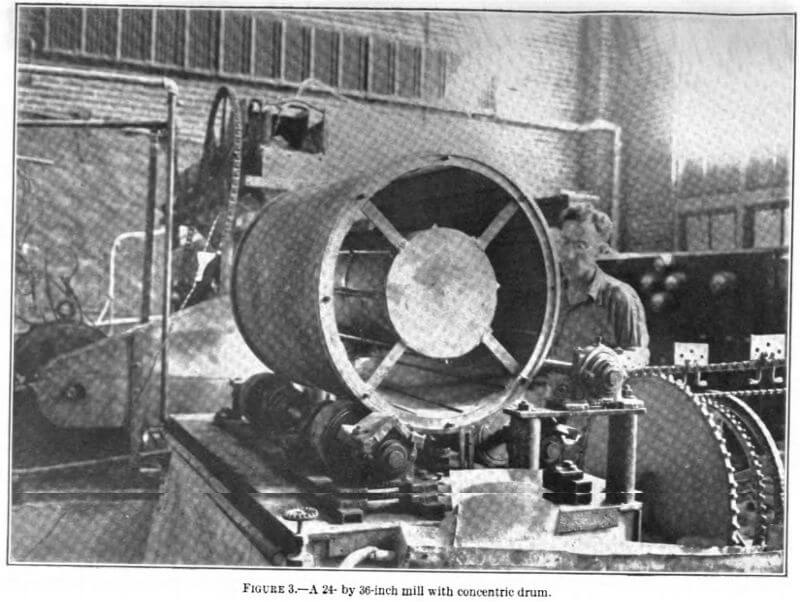
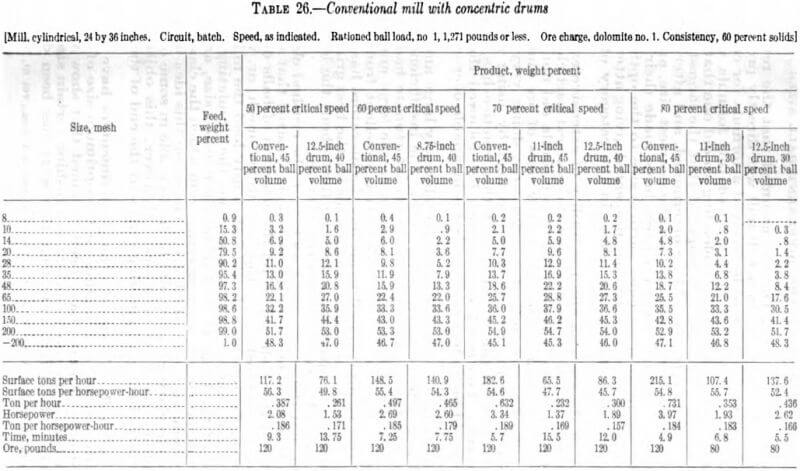
Rationing the Amount of the Different Ball Sizes
Conclusions on Innovations in Fine Grinding
- Tests with a variety of concentric drums in a cylindrical mill failed to justify the drum.
- In tests for the desirable relation of ball size to particle size, closely sized ore was used and credit was given only for grinding through the limiting screen. A formula for the ratio is given. The constant in the formula is different from others, which give the media credit for all of the products of the grind.
- Rationing the amount of the different sizes of balls to match all sizes and amounts of ore particles extending throughout the length of the mill was advantageous in studying the effect of segregation in the grid and conical mill. The improvement in efficiency, as compared with the customary practice, was from 58 to 28 percent, depending on the particle size in feed and discharge and on the circuit used.
- Tests for optimum size of balls brought out the fact that balls that were too large did nonselective grinding as well as balls that were too small.
- Tests with a long conical mill, with a mill made conical by a series of truncated cones apexing in the same direction, and with a mill containing a grid to segregate the sizes of media showed only a moderate advantage in efficiency as compared with a plain cylindrical mill. A long conical mill showed considerable loss in capacity. The grid would have been more effective if the oversize passing the grid could have been put back to the head of the mill.
- The grinding equipment used at Rolla is adapted to accurate forecasts of power and ball-mill size for specified tonnage. The nature of the products also can be predicted.
